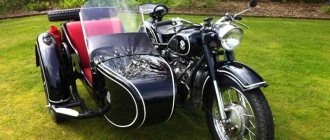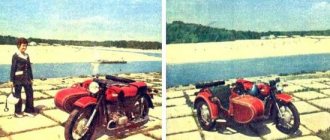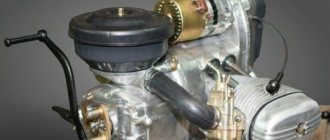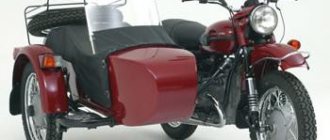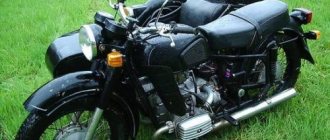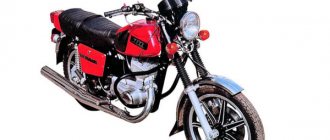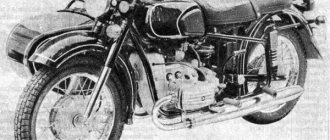History of the brand
"Dnepr", like "Ural", is a development of the M-72. Then it was modernized and received the K-750 with a more powerful engine. Next, the K-650 with an overhead valve engine was produced. Later, due to a change in the index system, the motorcycle was produced under the symbol MT-8. • Model MT-9 (1971) was distinguished by the presence of reverse gear. • Model MT-10 (1974) became the first Dnepr with a 12-volt electrical circuit and a two-spark ignition coil (one coil for two spark plugs). The gas tank capacity has also been increased. • Model MT-10-36 (1976), due to an increase in the compression ratio and new carburetors, had a power of 36 hp. • The most advanced model was the MT-11 (1985), which had a four-stroke engine with a power of 32 hp. p., 4-speed gearbox with reverse gear, drum brakes on all wheels, including the sidecar wheel, as well as a parking brake. The suspension was distinguished by a front telescopic fork and a pendulum suspension of the rear wheel. The maximum speed was 105 km/h, the load capacity was 260 kg. • There was an all-wheel drive all-terrain version of the MT-16 (1986) with a sidecar wheel drive. • Currently, the plant produces the Dnepr-11 (KMZ-8.155), Dnepr-16 (KMZ-8.922/KMZ-156-200) models; since 1991, the Dnepr KMZ-8.157-02 motorcycle without a sidecar has also been produced. In total, more than three million motorcycles have been produced since 1967. The engines of all models of heavy class motorcycles “Ural” and “Dnepr” have the same design. They are two-cylinder, four-stroke, carburetor, air-cooled and with opposed (located in the same plane towards each other) placement of cylinders in a horizontal plane. This arrangement ensures high balancing of the crank mechanism and good cooling conditions.
MOTORCYCLE "DNEPR" M 12 MADE IN 1983
How we brought the old Dnepr M 12 back to life
For many boys of that time, the Soviet “M 12” was not just a name, it was a huge part of childhood. For many, their first acquaintance with the technology of that time was in their grandfather’s garage; for many, this was their first trip to a rural disco and, of course, their first dream of owning their own motorcycle. In the territory of the former Union, in the 80s, the Dnepr M 12 motorcycle legends were very popular.
A little bit of our history
When I first saw our M 12, I just wanted to “hug and cry.” The restoration of this three-wheeled friend has become for us not only part of our professional activities and our favorite work, but also part of a large common cause to preserve the history of our Motherland. Our motorcycle was worn out by time and more than resembled a ghost. It needed technical and decorative restoration. There is a lot of work, it is difficult, but it was a challenge, and the Like Garage team of professionals and enthusiasts accepted it.
About the Dnepr M 12 motorcycle model
A strong frame and a powerful engine made this motorcycle a legend. He was popular not only among car enthusiasts, but also among all secular citizens. M 12 was one of the most powerful and comfortable representatives of the KMZ plant. It had a softer ride with hydraulic suspension. It was equipped with an additional wheel drive, which made its cross-country ability one of the highest among all moto vehicles in the country.
The power of the steel “horse,” which reached more than 2 m in length, was 21 liters. With. Maximum speed – 100 km per hour.
The positive qualities of the motorcycle are its thoughtful design and successful layout. It has a significant permissible load, good traction dynamics, high cross-country ability and a smooth ride.
Dnepr M 12 is easy to disassemble and adjust mechanisms, convenient to operate and reliable in operation. And, of course, it can be attached to a stroller.
How we worked on the restoration
Gradually removing detail after detail in the correct sequence, we labeled each of them. Like Garage professionals sorted all structural elements according to the degree of suitability and level of wear.
Soon, not only the 745 cc engine lay separately from the “body”. cm and a 4-speed gearbox, but also smaller, although no less important, parts of the motorcycle. We disassembled the stroller, removed the wheels, seat, as well as the power and braking system. As a result, we had in front of us a neat pile of motorcycle construction kit parts.
And then body work awaited the team. We thoroughly cleaned the “naked” skeleton of the steel monster from old paint, rust and visible dirt, straightened it and “patched holes” in places where it was needed. Some parts were welded to achieve the required integrity and strength of the structure. There was also a need for further painting of the motor skeleton with the selection of paint corresponding to the original. Also patched up and polished, the steel Mustang was treated to prevent corrosion.
Restoration work
The first and most important step on the path to perfection is the search and replacement of spare parts with authentic samples. When the three-wheeled giant fell into our hands, the condition of many parts required our direct intervention. It is worth recalling here that this model has a respectable age - it is more than 30 years old. Details were sought in a variety of places, including from private individuals, through advertisements on Internet sites and forums.
For high-quality restoration, we needed a lot of strength and patience from our craftsmen. It took us about six months to get the motorcycle back on the track. Although the process was long and very labor-intensive, we are glad that we got to work and brought life back to this retro beauty.
When the entire set was assembled, we began the phased restoration. And so what we did:
- Motor repair and troubleshooting. The 4-stroke two-cylinder engine was virtually overhauled, including repairs to the carburetor, exhaust and fuel supply systems, as well as cooling.
- Transmission repair. The gearbox and clutch system have undergone a major overhaul. The gearbox and some other transmission parts were completely replaced.
- Working with the chassis. All damaged parts were replaced with new ones. The steering mechanism was restored and its operation was adjusted. We also carefully worked on the brake system. All parts of the chassis and main units of the M 12 were sandblasted and painted.
- Debugging electrical wiring. The headlights and turn signals were cleaned and halogen lamps were installed.
- Detailed study of body elements (replacement, straightening and restoration).
- Wheelbase repair (including wheel balancing, replacement of old tires and hubcaps).
- Stroller repair (replacement of upholstery and leather upholstery of seats).
The Like Garage team managed to achieve maximum similarity between the restored miracle motorcycle Dnepr M 12 and the one released from the assembly line many years ago.
Gallery
WordPress Portfolio
Modifications of the Dnepr motorcycle
The MT8 engine
of the Dnepr K-650 motorcycle is a four-stroke air-cooled carburetor engine.
The engine uses an overhead valve timing mechanism, a cast crankshaft made of high-strength cast iron with removable lower connecting rod heads and replaceable connecting rod bearing shells. The design uses automotive-type liners, interchangeable with the liners of the Maskvich-408 car. The engine uses a forced lubrication system with centrifugal oil purification; bimetallic cylinders are used, which are more efficient than cast iron. Thanks to this, the engine has low thermal stress, the pistons in the cylinder are installed with a gap of 0.05-0.07 mm, the engine is reliable and durable. The MT9 engine
is a modernized model of the MT8 engine.
It uses a PM302 breaker with an automatic ignition advance. The MT8 and MT9 engines have a six-volt ignition system and a six-volt DC generator G-414. The MT10-36 engine,
unlike the MT9 engine, uses a twelve-volt ignition system; the engine crankcase has a mounting flange for the G-424 generator. The MT10-36 engine differs from the MT10 engine in increased power up to 26.5 kWh (36 hp). This was achieved by increasing the diameter of the intake valve head from 37 to 40 mm, using a camshaft with a new cam profile and an increased compression ratio to 7.5 units. The crankshaft rotation speed is increased to 5600-5800 rpm. In this regard, the shape of the valve recess at the bottom of the piston has been changed. The MT10-36 engine uses a carburetor, K301D, which differs from the K301B carburetor in the diameter of the diffuser and the increased throughput of the main fuel cylinder. In place of the PM302-01 breaker, the PM302-A breaker is used with a new design of the ignition timing device. Since November 1978 Pistons with a head sphere radius of 72.5 mm were produced. They were installed on MT10-36 engines when running on regular A-72 and A-76 gasoline with a compression ratio of 7.5 units, and on export motorcycle engines to run on high-octane A-93 gasoline with a compression ratio of 8.5 units. The distance from the piston pin axis to the outer surface is 48.2 mm. The shape of the groove for the exhaust valve in the piston has been changed. In order to maintain the compression ratio of the working mixture, a cylinder is installed on the MT10-36 engine, which differs from the cylinder of the MT9 and MT9 engines in the height of the installation size. The distance between the surfaces adjacent to the engine crankcase and the cylinder head is 107.7 mm. The MT10-32 engine is based on the MT10-36 engine. Unlike its predecessor, it has increased torque at low and medium crankshaft speeds, which makes it possible to significantly improve the traction and dynamic performance of the motorcycle for use in rural areas. The maximum speed of the motorcycle on the highway is 105 km/h, the maximum power in comparison with the MT10-36 is reduced by 3 kW and the rotation speed at maximum power output is lower by 700 rpm. The characteristics of the MT10-32 engine are improved as a result of the use of a camshaft with a modified cam profile. The camshaft of the MT10-32 engine is completely interchangeable with the shaft of the previous design. It can be installed on MT9, MT10 and MT10-36 engines. On the MT10-32 engine, instead of the MT801-237 piston with a spherical bottom, a piston with an ejector is installed, which has a flat bottom. The use of a new piston made it possible to improve the conditions for the formation of the mixture in the combustion chamber and reduce heat stress. In addition, in the MT10-32 engine the compression ratio was reduced to 7.0 units; the installation size in the cylinder was increased by 0.9 mm in comparison with the MT10-36 cylinder. New cylinders can be installed on all early released models of Dnepr motorcycles with MT engines. The modernized MT10-32 engine uses K63T carburetors.
Engine K-750
The K-750M engine is a four-stroke, two-cylinder, with a side-bottom valve arrangement and a prefabricated crankshaft. The connecting rods are mounted on roller bearings, the cylinders are cast iron. In its design, the K-750M engine is similar to the M72 engine, but has the following features: the compression ratio is higher, the camshaft rotates on a radial single-row bearing and a plain bearing, the pistons have two oil scraper rings, the breather design and the configuration of the front cover of the distribution box have been changed, the efficiency of the ventilation system has been increased . In terms of seats, the K-750M and M72 engines are interchangeable. The M67-36 Irbit motorcycle engine has such significant differences from the MT10-32 engine: its connecting rods together with the crankshaft form an integral structure and can only be removed with the help of special tools; a roller bearing with a separator is inserted into the lower head of the connecting rod; the cylinders are cast iron. The cylinders and their heads are mounted separately. The cylinders are attached to the crankcase with studs. Pushers with a rectangular head have guides, the rocker arm axes are installed in special brackets, which are mounted to the head using studs. The intake and exhaust valve heads have a smaller diameter. The low pressure lubrication system has a full-flow paper oil filter. The oil pump rotates from the camshaft. Gases from the crankcase are pushed directly into the atmosphere through the breather. According to the seats, Ural motorcycle engines; and "Dnepr" are interchangeable. The engines used on the Ural and Dnepr motorcycles include a crank mechanism, a gas distribution system, a crankcase ventilation system, and a lubrication system.
New Dnepr motorcycle engine
The main difference between the “Dnieper” engine and the “Ural” one, as is known, is the method of coupling the connecting rod with the crankshaft. At Dnepr it is made on plain bearings, i.e. on liners; They provide minimal friction during operation and are also (theoretically) very durable. But sliding bearings are more demanding on oil filtration and need to be supplied under higher pressure than roller bearings. Therefore, the lubrication system of KMZ engines is more complex than that of IMZ. The MT801 engine lubrication system, which includes an oil pump, a pressure reducing valve, a centrifuge located at the front end of the crankshaft for oil purification and channels made in the crankcase and the crankshaft. The oil supply from the centrifuge to the connecting rod bearings is carried out through sequentially communicated channels and cavities located in its connecting rod journals. These cavities are the second stage of oil purification, and their sequential communication ensures that the most refined oil flows to the more loaded bearing of the rear connecting rod. Also, an undoubted advantage of supplying oil from the filter to the connecting rod bearings through channels is the almost absolute reliability of this section of the oil line: all its elements are in one part, the length is the shortest possible, which causes low heating of the oil. Finally, with such a lubrication system, the part-support crankshaft is installed in the crankcase on rolling bearings - a design that has the highest mechanical efficiency and is also very reliable and simplest. The disadvantages of the MT801 engine lubrication system in general are its low reliability and high maintenance complexity. This is due to the fact that the oil is poorly filtered by the centrifuge mounted on the crankshaft due to its variable and relatively low rotation speeds during engine operation. During operation, it is necessary to regularly clean and rinse centrifuges, which cannot be done without disassembling the engine. Since the pressure reducing valve is installed in the pump located above the oil level in the engine crankcase, when clogged the valve does not fit tightly to the seat and without cleaning this unit, self-filling of the pump with oil is not possible. Cleaning the valve is labor-intensive, since it also involves disassembling the engine. Finally, it must be taken into account that with this lubrication scheme, oil is supplied to the crankshaft along a radius, and from the cavity of the front crankpin to the rear - through a radial channel. When the crankshaft rotates, a centrifugal force arises, counteracting the movement of oil in the radial channels and its flow to both the rear connecting rod bearing and the crankshaft in general. At high engine speeds, it is possible to overcome this centrifugal force and ensure lubrication of the connecting rod bearings only by increasing the oil pressure in the system. And this is associated with an increase in power consumption to drive the oil pump, a decrease in mechanical efficiency and engine reliability, since high pressure in the system contributes to its depressurization. These shortcomings were known to the engineers of the Kyiv Motor Plant for a long time. And therefore, back in 1980, KMZ developed an engine with a lubrication system that was fundamentally different from that described above. If it had been put into production at that time, the main competitor - the Irbit Motor Plant - would have been dealt a crushing blow. But the planned economy of those years decreed that the first production samples of these engines saw the light only 15 years later, in 1995. What is so special about the new engine and what is its difference from the old one? Analyzing the weak points of the old engine, the designers came to the conclusion that it was desirable to have a lubrication system for the connecting rod bearings in which the oil supply to them would not decrease at all as the crankshaft rotation speed increased and the maintenance of which would not require disassembling the engine. Ultimately, this would provide a significant increase in reliability and a reduction in the labor intensity of servicing such engines. In the new scheme, the goal is achieved by the fact that the oil line connecting the filter to the crankshaft is made exclusively in the gas distribution mechanism cover. A pressure reducing valve (drain or differential) is installed in it, a hollow cylindrical pipe is installed on the front axis of the crankshaft coaxially with the axis of its rotation, and a hole in the main oil line is made in the gas distribution mechanism cover. The cavities in the crankpins are connected in series to the receiving pipe by axial and radial channels and to each other by a bypass channel made along a circular arc passing through these cavities with a center on the axis of rotation of the crankshaft. The filter itself from the VAZ-2105 car is installed on the gas distribution mechanism cover. It consists of bypass and shut-off valves built into its body, as well as coarse and fine filter elements.
Improved engine oil purification system Dnepr
. 1 - oil pump, 2 - cavity in front of the filter, 3 - timing cover wall, 4 - shut-off valve, 5 - filter, 6 and 8 - fine oil filter element, 7 - oil line, 9 - bypass valve, 10 - bored part channel, 11 - oil line pipe, 12 - crankshaft, 13, 14 and 15 - parts of the oil line, 16 and 17 - cavities in the crankshaft housing, 18 and 19 - technological holes, 20 - drain valve, 21 - differential valve. Lubrication of the crank bearings of the connecting rods in the proposed system occurs as follows. Oil is directed by pump 1 into cavity 2, in the gas distribution cover 3, presses shut-off valve 4 and enters oil filter 5. If the oil is thick (with a cold engine), then in filter 5 it passes through the coarse filter element 6 and is sent to the main oil line 7 (channel with purified oil). If the engine is warmed up, then before entering line 7 the oil also passes through fine filter 8; if the filter elements are clogged, then the oil enters the line 7, squeezing out the bypass valve 9. From the main line 7, the oil is directed to the bore 10 and through the pipe 11 enters the crankshaft 12, in which it sequentially through channels 13, 14, 15, cavities 16 and 17, as well as holes 18 and 19, are directed to the crank bearings of the connecting rods. An excessive increase in oil pressure in the system is prevented by a valve: drain valve 20 (on sports engines) or differential valve 21 (for road motorcycle engines). With a differential valve, the valve control cavity is connected to the main oil line, and the recirculating oil supply is drained into the pan from the line in front of the filter. This reduces the forced circulation of the entire oil flow through the filter elements, which should increase their service life and reduce the passage of unfiltered oil to the rubbing parts in the filter, especially when the elements are partially clogged and the engine is operating at a low oil temperature.
Compared to the known ones, the proposed lubrication system has a completely new quality of self-regulation, which makes it reliable and easy to maintain and requires minimal engine power to drive the oil pump.
Indeed, when the crankshaft rotates, a centrifugal force acts on the oil in its channels, due to which it is sucked through pipe 11 from the main oil line 7 and under pressure (proportional to the square of the crankshaft rotation speed) through holes 18 and 19 in the connecting rod journals goes to the connecting rod bearings. Since oil is introduced from the main line into the crankshaft through hole 10 - pipe 11, coinciding with the axis of rotation of the shaft, and channel 15 is made along a circular arc with the center on the same axis, the resistance in the oil supply channels is almost zero. At any crankshaft rotation speed, the centrifugal forces in the indicated cavities and channel will always be the same. Due to this, when moving through bypass channel 15, the oil does not have to overcome significant centrifugal forces (0.45 MPa at a crankshaft speed of 8000 rpm). Therefore, the energy costs for moving oil through channel 15 are negligible and are equal only to the losses due to its friction against the walls of the channel. As a result, for normal supply of connecting rod bearings at any crankshaft rotation speed, an oil pressure in the main line 7 of about 0.1 MPa is sufficient. In this case, the oil flow through holes 18 and 19 in the connecting rod journals spontaneously sets (due to the action of centrifugal forces during rotation of the crankshaft) proportional to its rotation frequency. For comparison, we note that at average crankshaft speeds of the mentioned MT801 engine, the oil pressure in the system must be at least 0.35 MPa, and for normal oil supply to the connecting rod bearings of this engine at a crankshaft speed of 8000 rpm, the pressure reducing valve must maintain a pressure of system not less than 0.75 MPa. By the way, this was the reason for installing a centrifuge for oil purification on the engines of sports motorcycles, and then the Escort-78 motorcycles. Such high pressure does not allow the use of very convenient replaceable oil filters due to their limited strength. Installing a drain valve 20 after the filter in the gas distribution cover makes it possible to ensure high stability of the lubrication conditions of the connecting rod bearings when they wear out, when the oil viscosity increases and the hydraulic resistance of the filter increases, since in this case the pressure in the main line does not drop, as is the case if the pressure reducer the valve is located at the pump. This option for installing the drain valve practically eliminates its clogging (after all, there is filtered oil in line 7) and depressurization of the system. But even if this happens, the valve is easily accessible for inspection, adjustment and cleaning. In addition, it accelerates the achievement of high pressure in line 7 when starting a cold engine, which reduces starting wear on the connecting rod bearings. This is also facilitated by the indicated phenomenon of centrifugal self-regulation of the system and the high hydraulic resistance of the valve to cold (and viscous) oil. Making the oil filter as a separate unit mounted on the cover of the gas distribution mechanism ensures its easy replacement. In addition, oil cooling with a filter with a self-contained housing is better than with the IMZ engine lubrication system. Finally, such a low pressure in the main oil line, the simple configuration of the latter, the presence of only one moving interface in the channels with purified oil, the use of a very advanced oil filter for VAZ automobile engines, as well as the specified self-regulation effect due to the action of centrifugal forces on the oil, makes the proposed system lubrication is simple and extremely reliable in operation. Of course, the “Dnepr” with the new engine remained the same good old “Dnepr”: neither its power, nor its dynamics, nor its efficiency have changed. The only surprising thing was that during operation the engine never required attention to its person, be it the impenetrable forests of the Vepskaya Upland or the sands of Mangyshlak. During its entire life, from the date of release until complete wear and tear, not a single repair, large or small, happened to it, except for changing the oil and periodically adjusting the valves. In other words, it acquired a quality that sounds so unusual in relation to “Dnieper” engines: reliability.
This engine never made it into the main series. The dying plant has neither the strength nor the means to re-equip production. Engines with a modified lubrication system are assembled in very small quantities and are mainly exported, so it is quite difficult to buy such a motor.
MY MOTORCYCLE
An honorary escort (who also served as security) is a long-standing tradition. Since ancient times, ceremonial departures of Russian tsars and receptions of foreign embassies were accompanied by detachments of archers. In the 20th century, motorcycles replaced horses.
The history of the USSR honorary escort began in 1955, when the First Secretary of the CPSU Central Committee N.S. Khrushchev gave instructions to the commandant of the Moscow Kremlin A.Ya. Vedenin to create a motorcycle platoon to ceremoniously accompany government guests. Shortly before this, Khrushchev visited Yugoslavia, and he really liked the meeting organized there with the participation of a motorcycle escort.
The M-72 motorcycle was the first to serve as an honorary escort.
The choice fell on the M-72 produced by the Kyiv Motorcycle Plant (KMZ), which became the official supplier of the 9th Directorate of the KGB of the USSR for almost four decades. The first motorcycles, judging by the surviving photographs, belonged to different factory batches produced in 1955-56, as evidenced, for example, by two types of yokes for attaching the folding part of the rear wing. These cars differed from regular production ones primarily in their special black and white paint job and a large number of chrome-plated parts (including wheel rims, rear suspension shock absorber cups and air filter covers). Almost the only “special equipment” was the electric horns on the lead motorcycle.
The first M-72 motorcycles as part of the Honorary Escort.
The baptism of fire for the motorcycle platoon of the Separate Special Purpose Regiment of the Office of the Commandant of the Moscow Kremlin (OPSN UKMK), as the motorcycle unit of the honorary escort was officially called, was the visit of Yugoslav President Josip Broz Tito to the USSR in the summer of 1956.
At the end of the 50s, tires with white-painted sidewalls appeared on escort M-72s. At the same time, shields were installed that covered the driver’s knees. In photographs taken in the winter of 1959, windshields of the same type that were later used on the K-750 can be seen for the first time. In winter, escort motorcycles were operated with side trailers. This practice has continued to this day.
Meeting of cosmonauts A.G. Nikolaev and P.R. Popovich, August 1962.
Since 1961, instead of the well-deserved M-72, K-750 motorcycles began service. During the ceremonial meeting of the first Soviet cosmonauts, an honorary escort accompanied them in new cars. This model used a modified lower valve engine, boosted to 26 hp. The chassis was new: pendulum rear suspension and short-link front forks. Structurally, the escort K-750s were not very different from the production models; the difference was more in the configuration, quality of manufacturing and assembly. They received a softer “sagging” suspension, a “high-speed” pair in the final drive gearbox and a folding side stand. Some of the cars were equipped with rear-view mirrors, sound horns and a VHF radio station installed on the right side of the rear wheel.
Meeting of the crew of the Voskhod-2 spacecraft P. I. Belyaev and A. A. Leonov, 1965.
The last production motorcycles in the honorary escort service were the K-750M (since 1967) and K-650 (since 1968). The first one differed from the K-750 by a telescopic fork, unified with the Urals, and wheel hubs with labyrinth seals. And on the K-650, practically in the same chassis, there was a new MT-8 overhead valve engine. According to the recollections of veterans, the K-650 proved to be better than previous cars: it did not have the tendency to overheat, characteristic of lower valve engines. Therefore, the drivers themselves made the replacement, rearranging the MT-8 engine into the K-750M chassis.
Experimental motorcycle K-750M with an overhead valve MT-8 engine, 1968.
The new automatic ignition advance system turned out to be a rather problematic unit. Her work was considered unsatisfactory, and the honorary escort until 1979 received motorcycles with manual ignition timing adjustment.
The motorcycles were equipped with a hard windshield shield with built-in flashing lights. Most of the cars were radio-equipped. The black and white coloring traditional for escort motorcycles has slightly changed: on the gas tanks the white stripe has become horizontal, tapering towards the rear. According to the recollections of service veterans, at the request of the drivers, the girls working in the honor escort garage painted the edging of the white stripes with golden paint with a thin artistic brush.
Since, for a number of parameters, production motorcycles no longer met the requirements of the escort service, the development of special models began in Kyiv at the end of the 60s. The first in their series was the experimental vehicle K-650ES (aka “Dnepr-ES”), which entered testing at the Serpukhov VNIIMotoprom in 1968. Structurally, it was still a modification of the serial K-650, and it is only a stretch to consider it a special motorcycle. The most noticeable difference was the 18-inch wheels, which were used on all subsequent Escort models from then on. The driver's seating position has become more comfortable thanks to the cushion saddle. The wings, side decorative shields, knee guards, and also the wind shield were made of fiberglass. The shape of these parts was carefully selected to provide the best protection for the driver from dirt and wind. For the first time, a rear roll bar appeared. The body of the side stroller was also made of fiberglass, its frame was lightweight compared to the standard one.
Motorcycle "Dnepr K-650ES" of the "Escort-73" project.
The new car was given the factory name “Escort-73”, and from that moment on, the tradition of designating escort motorcycle models by the year of the planned launch into the series was maintained until the end of production. The device turned out to be very stylish. Due to the large windshield with a protective shield, deep fenders, and an abundance of chrome parts, it stood out from production motorcycles, and therefore, while traveling in a motorcade, it perfectly demonstrated the special status of the event.
One of the first photos of the K-650 motorcycle as part of the Honorary Escort. Visit of the President of Czechoslovakia L. Svoboda, 1968.
In parallel, the department of the chief designer of KMZ carried out work on the creation of “civilian” single motorcycles, which were either simplified versions of already developed escort vehicles, or independent projects, which, in turn, often served as a source of ideas for escort topics. One of the prototypes was the Dnepr-10.6 model. The plant announced it as a “motorcycle intended for export to highly developed countries.” In fact, this car was a two-seater version of the Escort 73 in a new frame. The motorcycle received 12-volt electrical equipment. From the Escort 73, he inherited fiberglass wings and a set of rear and front safety bars.
“Intended for export to highly developed countries” motorcycle “Dnepr-10.6”.
Another experimental machine created in the mid-70s was the DneprSpecial. It was designed as a single motorcycle with a long-term focus on the American market, but we are more interested in it as an intermediate step to another prototype - the Dnepr 12.9. On the “DneprSpecial”, which was based on a new frame, the designers used a five-speed gearbox, an “unfolded” driveshaft with an elastic coupling at the main gear, previously tested on the “Dnepr-2” version, and a new air filter from a VAZ car. The motorcycle received the “Zhiguli” combination of speedometer and tachometer, which was subsequently used on all escort cars. A new front fork design was also tested on this prototype.
Experimental DneprSpecial, aimed at the US market.
The next step was the installation of a new 750 cc 50-horsepower engine (factory designation KMZ-8.153.901), created on the basis of the sports 750 SK01, into the DneprSpecial chassis. This engine was combined with a five-speed gearbox without an automatic clutch. To meet the customer’s requirements for reliable starting of the motorcycle in frosts down to -40 degrees, it was necessary to develop a special battery. The mold for it was made at KMZ, and the batteries themselves, with a capacity of 32 Ah, were made in the experimental laboratory of starter batteries at the Podolsk Battery Plant. The parameters of this battery made it possible to equip the car with an electric starter, which was placed on the left side near the gearbox. The motorcycle received a new design rodless front fork with a hydraulic steering damper. The plant also carried out work to equip the front wheel of this model (designated “Dnepr-MT12.9”) with a hydraulic disc brake.
The first 750 cc device is “Dnepr-MT12.9”.
The technical project "Dnepr-MT12.9" was reviewed by the Ministry of Automotive Industry on December 11, 1976. The vehicle received a number of comments, and in the course of eliminating them, a new model was developed - “Dnepr-14.9” (KMZ-8.953). Thus, the electronic ignition system had to be abandoned due to the low reliability of the then available element base. The engine breather received a filter element in the front engine cover. The electric starter was placed at the top of the gearbox. German Bing carburetors replaced domestic carburetors.
One of the first versions of the Dnepr-14.9 motorcycle.
The first pre-production Dnepr-14.9 was sent to the Special Purpose Garage in 1978. Based on the test results, the customer made a number of comments, which the plant tried to eliminate. However, some diseases haunted the motorcycles of this model until the end of operation. Stability and controllability at high speeds caused serious complaints. But, despite all the shortcomings, the car was a success.
President of the SFRY J.B. Tito in Moscow. The motorcade includes both K-750M and K-650 motorcycles, 1972.
The production of the first batch of 25 special escort motorcycles took more than two years, and they were delivered to the customer only in 1979. The Dnepr-14.9 engine was assembled and tuned at VNIIMotoprom in Serpukhov.
"Dnepr-14.9" from the first batch of 1979.
On December 27, 1980, the USSR Ministry of Automotive Industry approved the terms of reference for a fundamentally new motorcycle for an honorary escort - “Escort-86”. At the request of the customer organization, he had to receive a 950 cc engine with a power of at least 64.5 hp, a five-speed gearbox with reverse gear, cast wheels, a double-disc front wheel brake, a front fork with aluminum pipes and a number of other modern features. that moment of constructive decisions. In July 1983, the Kiev Motor Plant produced two prototypes for testing. The engine had to be developed virtually from scratch: it received a solid steel crankshaft with Zhiguli main and connecting rod bearings, a horizontal crankcase connector, and a camshaft chain drive. However, soon the work had to be suspended: the new motorcycle turned out to be technologically too complex for the production existing at that time.
In a report to the Scientific and Technical Council of the Ministry of Automotive Industry, Fr.
Experimental Escort-86 with engine number 38 from the author’s collection.
One can only be surprised at the peculiar logic of the “higher authorities”: the plant followed the customer’s requirements when creating a new motorcycle, and it was the designers who were accused of new developments.
The first prototype of the Escort-86 motorcycle with a 950 cc engine.
As a result, the Escort-86 project was actually reduced to a deep modernization of the Dnepr-14.9. The first two prototypes were produced and submitted for testing only in December 1986. Based on customer comments, the machines were redesigned several times, and only in 1988 the Kiev Motorcycle Plant began manufacturing a batch of 25 Dnepr-14.9M motorcycles. They differed from the previous model not only in their design, but also in their new design. The large area front fairing was now rigidly attached to the frame. At first, this created some difficulties when retraining drivers who were accustomed to “feeling a turn” by the position of the front wing. The mufflers were raised, which made it possible to tilt the motorcycle at a greater angle in turns. The electrical system provided for different switching, the use of original signal lights and a number of new instruments placed in a special container with sealed plug connectors, an instrument panel with a clock and an ammeter. To satisfy fashion requirements, the number of chrome parts was reduced. Factory engineers put a lot of effort into making the entire design of the motorcycle lighter. The rear swingarm, made of a rectangular pipe, has become longer, increasing the base of the car. The stroller has also been completely redesigned.
"Dnepr-14.9" from the second batch of 1984.
"Dnepr-14.9M" became the last escort motorcycle of the Soviet Union. In 1993, these machines in the “summer” single version were replaced by BMW K75RT motorcycles, while the “winter” version continued to serve until 1996, when it was also replaced by the BMW K75RT with a sidecar.
70s, the motorcade included Dnepr-650ES motorcycles.
To complete the picture, it is worth remembering the shipment of motorcycles for the Leningrad escort service. In the mid-80s, the customer began operating a new batch of machines and returned the previous ones to the plant. When, at the end of the decade, an escort unit appeared in the Leningrad traffic police, its chief B.N. Gavshin offered to give these motorcycles - restored and modernized - to him. Thus was born the model “Dnepr-14.9L” (KMZ-8.954), a combination of a serial 650 cc engine with components (five-speed gearbox, electric starter, chassis elements, fairings) of special escort vehicles.
"Dnepr-14.9L" for Leningrad.
Nowadays, a large collection of escort motorcycles restored by the Riga workshop “Moto-Phoenix” (team of restorers: Alexey Popov, Volodimir Seko, Andrey Silin, Vitaly Sinevich, Igor Sazonchik, Andrey Verdiyan) is in the FSO museum and periodically appears at Ilya’s Oldtimer Gallery Sorokina." Do not miss!
Motorcycle "Dnepr-14.9M".
The 1972 motorcade included K-650 motorcycles.
Issue: MOTO Magazine – March 2016
Author: Alexey POTAPOV, photo of the author, and also from the author’s archive, Special Purpose Garage, Alexander SOROKIN, Andrey MOROZENKO
Motorcycles Dnepr and Ural - Differences between the MT-10-32 engine and the MT-10-36
The practice of operating the Dnepr MT10-36, produced by the Kyiv motorcycle plant, has shown that the basic parameters of its engine do not fully satisfy motorcyclists living in rural areas. Thus, when driving on dirt, cobblestone, crushed stone roads, they almost never use the maximum power (36 hp), achieved at very high speeds (5900 rpm), and the torque, which determines the traction properties of the engine, is insufficient at low speeds. and averages typical for such conditions. Because of this, you often have to change gears while maintaining high revs, which requires a certain amount of skill and physical effort and entails additional fuel consumption. Since heavy motorcycles are used mainly in rural areas, the plant has modernized the engine to better suit these conditions. The new engine designation is MT10-32, and since mid-1985 it has been installed on the Dnepr-11 and Dnepr-16. Comparing the external speed characteristics (Fig. 1) of the MT10-36 and the modernized engine, we see that in the MT10-32 the maximum power and torque are shifted towards lower crankshaft speeds. Moreover, the torque has increased to 50 Nm and varies little over a fairly wide speed range. The maximum power has become somewhat lower, but at more frequently used speeds it has increased noticeably. As a result, the traction and dynamic qualities of the motorcycle have improved, and the so-called adaptability coefficient has increased, which characterizes the engine’s ability to maintain crankshaft speed when the load increases. Now it is easier to ride a motorcycle on bad roads (without compromising high-speed traffic on the highway), and it is less necessary to change from one gear to another. What design changes has the engine itself undergone? Instead of pistons with a spherical bottom, pistons with a displacer and a flat bottom are used here (Fig. 2). Its catalog number is KMZ 8.155 01 237. With the new piston, the quality of mixture formation in the combustion chamber has improved and heat stress has decreased. The pistons of the old and new designs are completely interchangeable and suitable for all previously produced Dnepr engines - K-650, MT9, MT10, MT10-36. However, they are replaced only in pairs. In order to reduce the thermal stress of the engine, when, while driving on a difficult road at low speed, the cylinders are weakly blown by the oncoming air flow, and also to reduce the engine’s demands on the quality of gasoline, the compression ratio was reduced from 7.5 to 7.0. This was achieved by increasing the cylinder height by 0.9 mm (the distance between the surfaces adjacent to the block and the cylinder head, Fig. 3). Otherwise the cylinders are exactly the same. Finally, the profile of the camshaft cams has been changed, which ensures favorable torque characteristics. The plant will supply new pistons, cylinders and camshafts to the retail chain not in sets, but separately. Cylinders with a size of 108.6 mm can be installed on all previously released Dnepr motorcycle models with an MT engine. At the same time, in order to prevent possible oil leakage from under the sealing rubber caps on the rod casings due to weakening of their clamping force, it is recommended to install a metal ring (washer) with a thickness of 1.0, an outer diameter of 23, an inner - 17.6 mm. When using new pistons, you must remember that they are selected with the same color index as the piston pin and the upper head of the connecting rod, and their masses must be the same. Before installation, the piston is heated to a temperature of 80-100 degrees and connected to the connecting rod so that the arrow on the bottom of the piston is directed towards the centrifuge. The cylinders are selected so that the installation gap between the largest diameter of the piston skirt and the cylinder is within 0.05-0.07 mm. Before installing the cylinders, the rings on the pistons are spread so that the joints are at an angle of 120° to one another, and the cylinder surface is lubricated with oil. When installing the cylinder head, the nuts are tightened in two stages: first, evenly with a small force, and then finally with a force of 2.8-3.6 kgf m.
Motorcycle Dnepr 12 MT
Hello! “Vse-o-moto” is a classic website about modern bike building, which also tells about the historical features of motorcycle building. We will touch upon some of our sections on modern biker tuning. We will talk about what individual owners of iron horses are like, united under the banners of powerful biker clubs.
About the 12th series of KMZ
The Dnepr 12 MT motorcycle is nothing less than a local legend. Today we are ready to present to your attention a delicate topic concerning the famous Ukrainian motorcycles, the history of which simply cannot but be connected with the Soviet history of motorcycle construction. Let's talk about MT Dnepr Twelve.
Tens of thousands of residents of the Soviet Union managed to purchase this steel unit. As you already know, cargo motorcycles were in great demand in the village. Large cubic capacity was actively purchased in the recent past, since it had no analogues from China at that time, and gasoline was not the same as today... The Dnepr 12 MT motorcycle or the Ural M 62 motorcycle were sold out in huge quantities. These heavy bikes, which also had a very spacious sidecar, were the pride of the domestic motorcycle industry.
The load that these iron horses could move quite quickly could sometimes frighten with its weight or volume. Yes, the cross-country ability of this motorcycle equipment was quite high. These iron horses could easily compete with passenger cars and “punish” the latter in certain positions.
The Dnepr 12 MT motorcycle showed off its technical characteristics left and right. Solid power of 26 horses allowed the bike to have unprecedented power. Both on soft ground and on hard asphalt surfaces, these motorcycles served our population faithfully and also faithfully.
Features of the 12 Dnepr motorcycle
The drive of this iron horse had very successful performance. On the side of the bike (on the sidecar) there is a wheel that is connected to the power transmission. Thus, the bike from the Kyiv Motor Plant avoids unnecessary movement resistance. The stroller does not follow its own track. The Ukrainian manufacturer began producing motorcycles with such know-how in its anniversary year.
Thus, the Dnepr 12 MT motorcycle received an important feature that previous bikes did not have.
Still, the lower-valve engine was borrowed from previous motorcycle series. Although there are differences here too. After a slight modernization of the power unit, the Twelfth Dnepr managed to achieve a smooth change in power as well as torque. This allows the KMZ motorcycle to easily adapt while riding in different road conditions. Now you don’t need to shift frequently, loading the gearbox. The slightly boosted power unit of the above iron horse is quite durable in operation. At the same time, it is still easy to repair and maintain.
Like previous models of bikes from the Kyiv Motor Plant, the Dnepr 12 MT motorcycle is equipped with a reverse gear. It allows this steel monster to be as maneuverable as possible.
It should also be noted that the technical features of the Dnepr MT of this series may differ depending on the year of manufacture. And this powerful cargo bike was produced from 1982 to 1985. Then the “16” models came off the assembly line, but they will be discussed in another article in this section.
